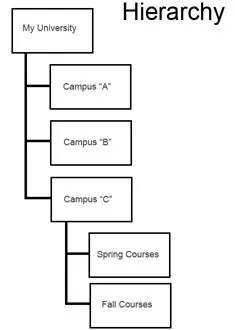Institutional Hierarchy and Domains
Both the Institutional Hierarchy and Domains offer flexible administration models. Each can:
- Organize users, courses and organizations
- Delegate administration
- Assign different administrative responsibilities to users
The Institutional Hierarchy does this through a user interface by making a tree that allows System Administrator to add the administrators, courses, organizations and users to each hierarchy level node. Any user can be added as an administrator and given specific administrator roles for each hierarchy level node.
Domains make sets using rules to group objects. The attributes of the objects determine which sets they are in and who can administer them. To learn more, see About Domains.
For example, with Domains a user can be the Course Administrator of All Unavailable Courses - as soon as a course is made available, it is gone from their scope. With Institutional Hierarchy, a user can be the Course Administrator of the College of Arts and Sciences. The user and the courses must each be added to the College of Arts and Sciences hierarchy level node.
The primary difference between Hierarchies and Domains is the way the permissions are assigned. Hierarchies provide permissions based on the location, whereas Domains provide permissions based on criteria. A Hierarchy administrator will still have access to courses regardless of whether they are marked as available or unavailable, as long as the course is still located in the Hierarchy to which the administrator has access. A domain administrator will no longer have access to a course if the course is marked as unavailable, no matter the location if their permissions do not extend outside of available courses if their domain permissions apply only to available courses. Domains are rule-based, Hierarchies are location-based. Domains make sets of rules-based groups of objects so that the attributes of the objects themselves determine which sets they are in and therefore who can administer them. Hierarchies make trees so that the location of the objects determines who can administer them.
Institutional Hierarchy and other Blackboard hierarchies
The Institutional Hierarchy, Outcomes Unit Hierarchy, and Course Catalog are all designed for specific purposes and do not interact with each other.
- The Institutional Hierarchy is designed to delegate administration tasks to other users when appropriate
- The Outcomes Unit Hierarchy is available only if your school licenses outcomes assessment. It is designed to represent both the academic and administrative units of an institution with the purpose of aggregating data to a specific level of the institution.
- The Course Catalog is designed to display courses in the catalog itself.


